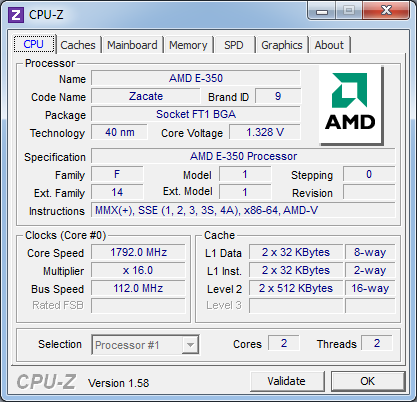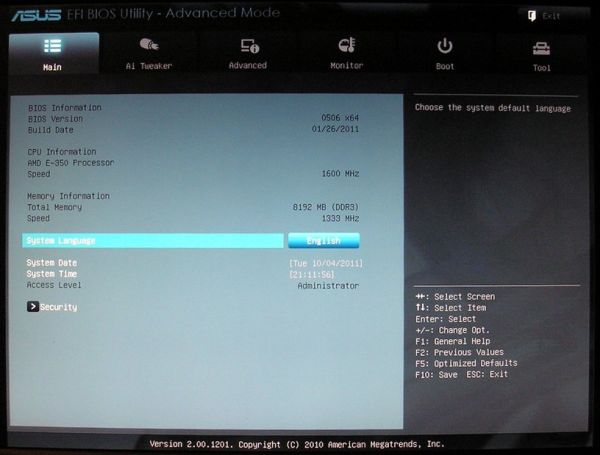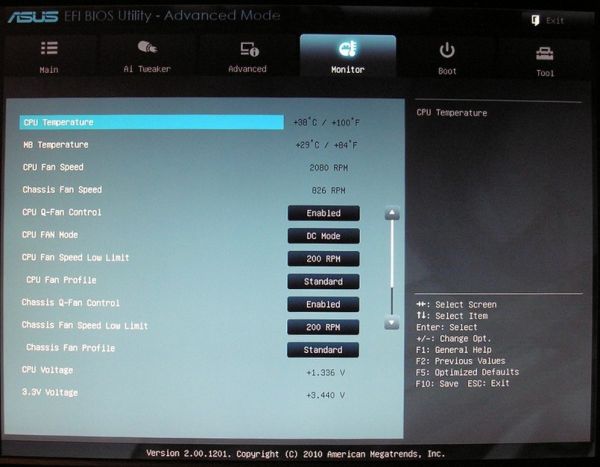ASUS E35M1-M Pro Review - Anyone For Fusion?
by Brendan van Varik on October 25, 2011 5:00 AM EST- Posted in
- Asus
- Motherboards
- Fusion
- E-350
BIOS
When you first enter BIOS, you will notice that ASUS have used a graphical BIOS with this motherboard. The BIOS itself is very easy to navigate through and when you get into it for the first time, you are faced with the ‘EZ Mode’ which shows you the basic things which a user may use or need to change such as the boot order of the system. When you enter the ‘Advanced Mode’, it opens up the entire BIOS so that you can turn things on or off which you would not find in the basic setup.
It is nice to see that overclocking features have been included in this BIOS but I do not think that many users will be buying this motherboard with overclocking in mind, as that will only raise power consumption and temperatures.
The fan controls in the BIOS allow you control both fan headers on the motherboard. You have a few options available which allow for either optimized cooling based on temperature, or if a quiet computing experience is preferred, that option is at your disposal too.
There are no noticeable changes between the release BIOS and the latest BIOS which is available on the ASUS website. ASUS claim improved system stability is achieved with the latest release although I have not experienced any issues on the shipped BIOS.
Overclocking
While overclocking may not be a strong point of this motherboard, it is still possible to squeeze a bit of extra performance out of the APU. I started with the ASUS Suite II software to see how good the automated overclocking was. The auto-overclocking feature added 3 MHz to the bus speed which increased the overall CPU speed by 48 MHz to give a final clock speed of 1648 MHz. The same overclock is applied if you select the AutoTune feature within the BIOS. It was stable but the increase in performance was not that noticeable.
Going through the BIOS, I was able to achieve a better result. The APU has a stock clock speed of 1.6 GHz and I was able to push it up to 1.792 GHz by using a 112 MHz base clock. All voltages were left on auto. When I went any higher than 112 MHz on the base clock, the motherboard would occasionally have an issue getting into Windows. However, from a stability standpoint, everything worked flawlessly at 112 MHz.

Along with standard stability tests, for completeness, the system was put under a 100 per cent loading for ten minutes and then the PC was put into a sleep state for the night. It switched on in the morning without any issues and full usability. When a 112 MHz base clock was used, there were no issues and the system was fully usable.


















66 Comments
View All Comments
C300fans - Tuesday, October 25, 2011 - link
1, If DXVA 2.0 works FLAWLESSLY , it works.2, It is good.
spaceyyeti - Tuesday, October 25, 2011 - link
1. Yes, it can. Even 1080p flash (on windows) is kidsplay for fusion.2. Way better then Intel's. I run linux and I get some glitches, but those are really really rare. Under windows there are no problems at all.
C300fans - Tuesday, October 25, 2011 - link
2, If you use cpu to decode high rate files, it will have obivous glitches.spaceyyeti - Tuesday, October 25, 2011 - link
it's not a cpu problem. the ati linux drivers are not that great lately, so uvd3 support is still a bit problematic. but as I said; the glitches are rare. some movies get none, others get 1 or 2 in an hour. they are not annoying or even that noticeable. and yes, I checked my codecs :-) the main problem with the ati drivers nowadays is bad support for gnome-shell/gnome 3. artifacts al over the place. haha. but that's not really relevant to this article.plonk420 - Wednesday, October 26, 2011 - link
it's not high bitrates that have issues, it's retarded settings that go out of Level 4.1 specs, like 16 reference frames @ 1080p.i just wish this was ~20-30% faster and 1/4th the GPU speed. it's just ever so slightly too slow for Spline scaling in ffdshow, IIRC.
Meegulthwarp - Tuesday, October 25, 2011 - link
Nice to see a power supply that reflects what most people would be using with this setup. It would be interesting to have a comparison between this 250w and a 1000w to see if all the haters were correct.Once again, nice review. Currently looking for a HTPC for my new flat. Just worried AMD might release a refresh of Fusion when I buy one. Anyone know if there is a refresh on the horizon?
spaceyyeti - Tuesday, October 25, 2011 - link
The E-450 is coming. Higher CPU and GPU clockspeeds (cpu: 1,65ghz gpu: 508mhz with 600mhz turbo) and a better memory controller supporting 1333mhz. But you can do that with this board too, by just selecting it in the bios.Other than that, you'll probably have to wait for a process shrink.
http://www.anandtech.com/show/4407/the-brazos-upda...
Meegulthwarp - Tuesday, October 25, 2011 - link
Thanks, I thought I saw that but couldn't find it. Might just mull it over and give the E-350 a pass for the time being.lestr - Tuesday, October 25, 2011 - link
Ancient history folks. Asus has updated to the 450. Boards have been available in Asia and Europe for weeks now. Slight bump to 1.65 and RAM std upped to 1333, OC 1600. No idea how it would test out - hasn't been done yet. Can't understand why they only have 3 analog audio outs on the rear. BIOS tweaks? who knows.I sent an e-mail to Anand 2 weeks go asking him to get Gary to send one over... Oh well.. we'll see who gets it first. Nice try and a good re-introduction.
silverblue - Tuesday, October 25, 2011 - link
I'm very interested to see if the extra memory bandwidth does anything for the HD 6320 or if it runs out of steam, in which case AMD would've been right to only include a single channel memory interface.